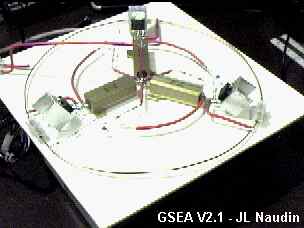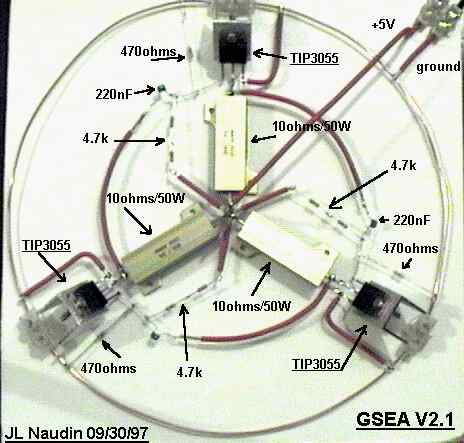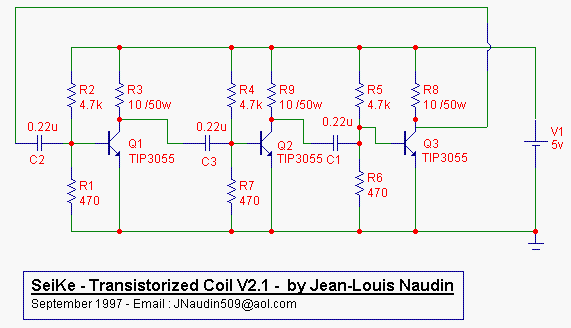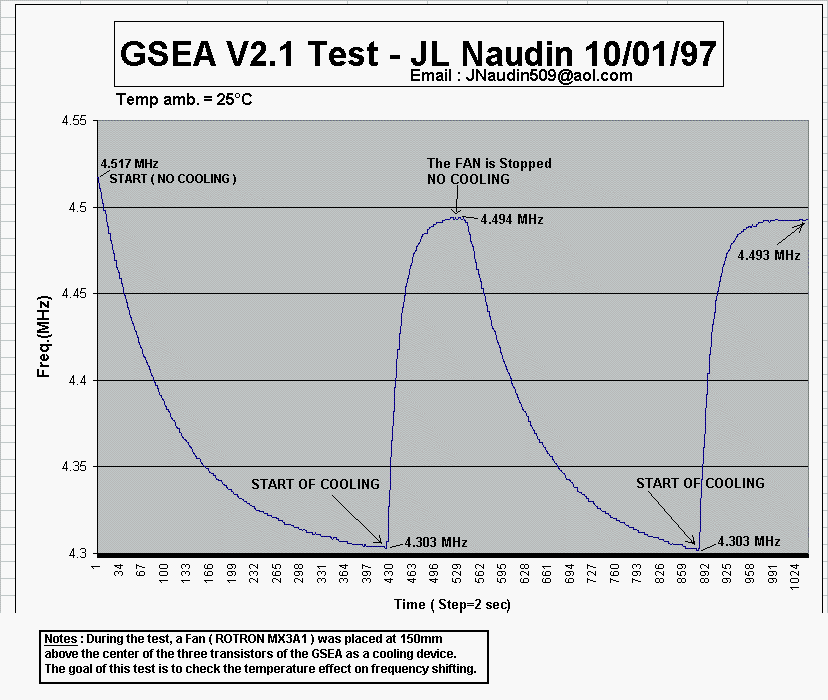

G-Strain Energy Absorber V2.1 - Tests
A part of the TEP project
created on 10/01/97 - JLN Labs - last update on 10/01/97

Based on work of Prof. Shinichi Seike, I have build and successfully tested an improved version of his G Strain energy absorber .
The text below is a part of an article presented at the Toronto Congress : "Abbreviated Report on Prof. Seiki" : SEIKE1.ASC
The full text of this document can be found at URL :
http://www.keelynet.com or
http://www.eskimo.com/~billb/freenrg/keely.html
The Transistorized Coil: A Novel, Clean
Energy Tool
As calculated by Lev Davidovich Landau, Nobel laureate in Physics (1962) G strain energy (also known as the Landau g factor) of:
w = (-g²)/(8*pi*k[erg/cm^3]), (1)
is stored throughout the entire terrestial space, where: g = 980 cm/sec²,
and k stands for Newton's g constant of: k = 6,670 x 10^-8 dyn. cm²/g.
With this in mind, it is known that the energy of:
w = -5.4 x 10^11 erg/cm^3 (2)
is present in our terrestial space. This energy is available and could become a clean energy source and be potentially more available than Nuclear Fusion.
It has been, however, difficult to convert g strain energy into electric power because it is in a state of negative energy. One is reminded that in Paul A.M. Dirac's Theory of Particles and Anti-Particles, there are four states of entity:
States 2) and 3) are in a negative energy state, while states 1) and 4) are considered to be in a positive one. From this, one knows that it is necessary to convert the g strain energy into power with "holes" (the unoccupied state of the electron)............
G Strain energy absorber
A closed amplifier (transistorized coil) can be designed to absorb the G strain energy. As is known, the p type of semi-conductor carries "holes" (unoccupied state of electrons). In order to absorb G strain energy, such material is required. Though a semi-conductor coil is desirable, ist is difficult to obtain. Hence, a transistorized coil is selected since either silicon or germanium may be used as transistors.
...........
Often it is discused in quantum physics that the energy of quanta is proportional to angular frequency such that:
W = h/(2*pi*w) (3)
W = hf (4)
where h/(2*pi*w), h and w stand for Planck's constant, Planck's one and the angular frequency of:
w = 2*pi*f (5)
respectively. This result maintains that the energy of the system decreases with time by absorbing negative energy of G with transistors.
Some features of the novel energy
This energy is quite different from ordinary electrical power because it is negative. It will have a low temperature, since the thermal energy of negative energy can be computed to be:
kT < 0,
where k and T denote the Boltzmann constant and the Kelvin temperature, respectively. The transistorized coil would scarcely emit heat when a large "hole" current flows; it is quite clean. Yet, the magnetic field can be generated, since a "hole" owns a charge. Physicists have intuitively felt that G energy would not be easily melt, since it is frozen onto the background space. This has, indeed been true as one uses an ordinary copper coil.
However, the use of a transistorized coil makes possible the acquisition of that same energy.
G strain energy is limitless and free. In this sense, our method is quite revolutionary. With the transistorized coil, one can obtain an endless supply of electric power, where and when it is required, beyond the limits of sources of supply and transportation requirements.
Only conversion apparati are required. Owing to the pair production concepts of Paul Dirac, matter and particles can literally be boren out space itself! This space is, as it were, the mother of entity. Thus the "space age" follows the atomic age. The power of G strain energy is more advanced than nuclear power as it is a more advanced philosophy in quantum physics and relativistics.
Shinichi Seike
DESIGN AND DIAGRAM

Setup of the electronic components

The "Flat" electronic diagram
TESTS RESULTS :
This round amplifier i.e. called, therefore, Endless Amplifier, which makes single turn of semiconductor coil. This version of the GSEA V2.1 is quite different from the original Seike's design ( which use 3 transistors 2SC521 (Silicon NPN, Triple diffused MESA transistors) ). As far as I am concerned, I have used three TIP3055 and this setup give me indentical results and now, I can confirm that :
- The frequency decreases second by second, minute after minute as indicated on the following table BUT this effect seems produced by the thermal drift of the transistors used.

Equipement specifications :
- Voltcraft VC506 connected on a PC computer though the serial port for the data recording, (accuracy +/-0.01%+2ddgts)
For all ranges input impedance of 10MOhms shunted with <1nF and an input sensitivity of 0.7 Vrms (=effective), sine-shaped.
- PM3215 2x50 Mhz Philips with 1/10 corrected probes.
- Switching power supply for computer ( 220V/ 5V DC ) : ASTEC AA11771C (output voltage 5.17V)
- also tested with conventional power supply and lead acid battery.
- Cooling fan for computer : ROTRON MX3A1 220V

Notes from Jean-louis Naudin :
The main goal of this test is to verify if the temperature as a major effect Vs the "G Energy pumping effect" on the frequency shifting.
I have mounted a fan ( used for CPU for big computer ) at 150mm above the center of the GSEA's axis ( just in the center of the three transistors (for an equal cooling).
The test have four phases ( ambiant temp = 25° c):
This first series of tests shows clearly the temperature effect on the frequency shifting. So, today, I can't confirm that "The G energy pumping" decrease the frequency of my version of the Seike's Transistorized coil.
I need to find MESA junction type transistor and reconduct this test to be in conformity with the original design of Prof. Seike. If someone could help me to find this kind of transistors ( with an european reference, please ), he is welcome....